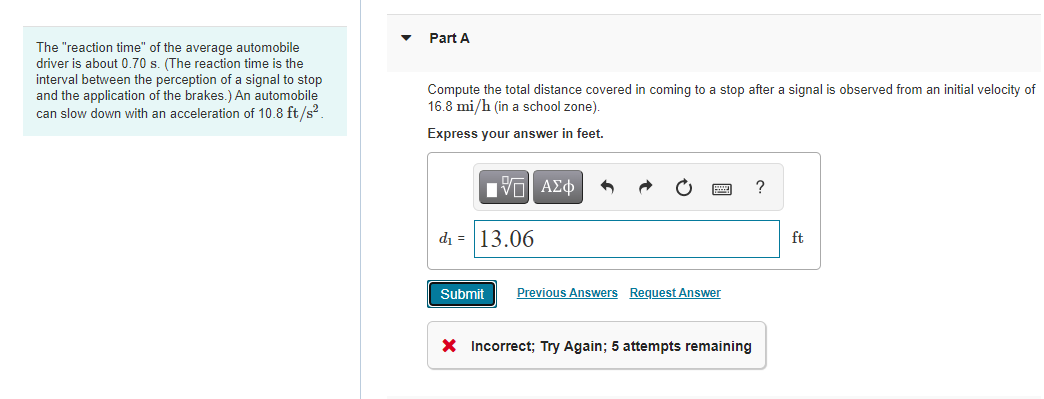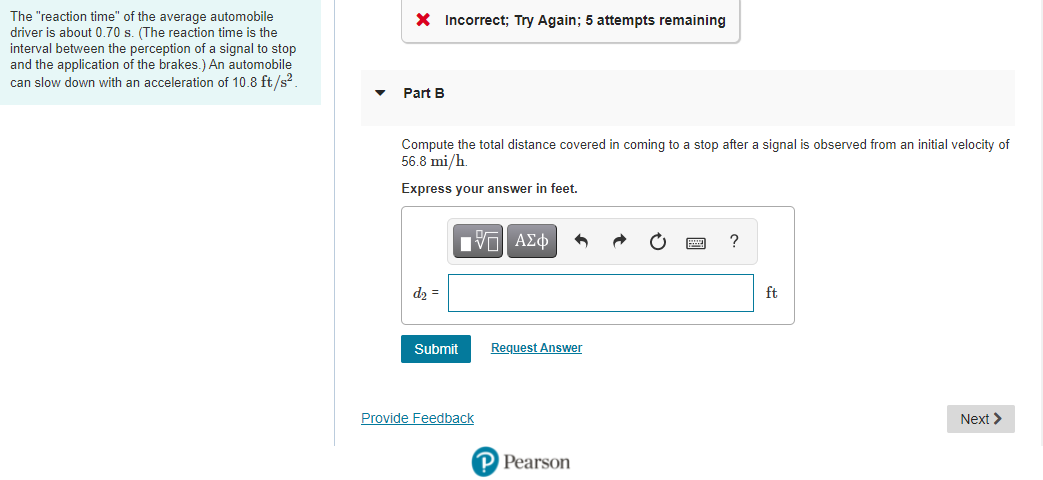Part A The "reaction time" of the average automobile driver is about 0.70 s. (The reaction time is the interval between the perception of a signal to stop and the application of the brakes.) An automobile can slow down with an acceleration of 10.8 ft/s?. Compute the total distance covered in coming to a stop after a signal is observed from an initial velocity of 16.8 mi/h (in a school zone). Express your answer in feet. nν ΑΣφ ? di = 13.06 ft Submit Previous Answers Request Answer X Incorrect; Try Again; 5 attempts remaining
Part A The "reaction time" of the average automobile driver is about 0.70 s. (The reaction time is the interval between the perception of a signal to stop and the application of the brakes.) An automobile can slow down with an acceleration of 10.8 ft/s?. Compute the total distance covered in coming to a stop after a signal is observed from an initial velocity of 16.8 mi/h (in a school zone). Express your answer in feet. nν ΑΣφ ? di = 13.06 ft Submit Previous Answers Request Answer X Incorrect; Try Again; 5 attempts remaining
University Physics Volume 1
18th Edition
ISBN:9781938168277
Author:William Moebs, Samuel J. Ling, Jeff Sanny
Publisher:William Moebs, Samuel J. Ling, Jeff Sanny
Chapter3: Motion Along A Straight Line
Section: Chapter Questions
Problem 82AP: Professional baseball player Nolan Ryan could pitch a baseball at approximately 160.0 km/h. At that...
Related questions
Question
Physics help in Chapter 2 Motion of a Linear Line

Transcribed Image Text:Part A
The "reaction time" of the average automobile
driver is about 0.70 s. (The reaction time is the
interval between the perception of a signal to stop
and the application of the brakes.) An automobile
can slow down with an acceleration of 10.8 ft/s?.
Compute the total distance covered in coming to a stop after a signal is observed from an initial velocity of
16.8 mi/h (in a school zone).
Express your answer in feet.
ν ΑΣφ
?
di = 13.06
ft
Submit
Previous Answers Request Answer
X Incorrect; Try Again; 5 attempts remaining

Transcribed Image Text:The "reaction time" of the average automobile
driver is about 0.70 s. (The reaction time is the
interval between the perception of a signal to stop
and the application of the brakes.) An automobile
can slow down with an acceleration of 10.8 ft/s?.
X Incorrect; Try Again; 5 attempts remaining
Part B
Compute the total distance covered in coming to a stop after a signal is observed from an initial velocity of
56.8 mi/h.
Express your answer in feet.
d2 =
ft
Submit
Request Answer
Provide Feedback
Next >
P Pearson
Expert Solution
Step 1 - Introduction
Given
reaction time of the average automobile driver
acceleration
Trending now
This is a popular solution!
Step by step
Solved in 4 steps

Knowledge Booster
Learn more about
Need a deep-dive on the concept behind this application? Look no further. Learn more about this topic, physics and related others by exploring similar questions and additional content below.Recommended textbooks for you

University Physics Volume 1
Physics
ISBN:
9781938168277
Author:
William Moebs, Samuel J. Ling, Jeff Sanny
Publisher:
OpenStax - Rice University

An Introduction to Physical Science
Physics
ISBN:
9781305079137
Author:
James Shipman, Jerry D. Wilson, Charles A. Higgins, Omar Torres
Publisher:
Cengage Learning

University Physics Volume 1
Physics
ISBN:
9781938168277
Author:
William Moebs, Samuel J. Ling, Jeff Sanny
Publisher:
OpenStax - Rice University

An Introduction to Physical Science
Physics
ISBN:
9781305079137
Author:
James Shipman, Jerry D. Wilson, Charles A. Higgins, Omar Torres
Publisher:
Cengage Learning